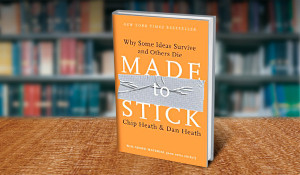Wanna learn how to make ideas stick? Of course you do.
6 principles for making ideas stick…with real life examples.
A cheat sheet (or summary) of the book Made to Stick.
6 Principles to make any idea STICK!
1.) Simple:: The idea has to be really broken down. Trim off anything that isn’t 100% needed and find the core.
A) Find the Core – determine the single most important thing, being careful not to bury the lead.
- The military uses a “Commander Intent” instead of a plan. For example, rather than details on how to take a bridge, the CI might be “take the bridge.” I used this tactic at a recent meetup and it worked! I created a huge itinerary for the event, knowing that something would change but I made it clear to the host that no matter what happened, I had a very specific goal. Here’s the proof (fast forward to 1:01)
- Use the technique of the inverted pyramid from journalism: Tell most important aspect first, then tailor, then add details. This forces prioritization.
- An example of an idea (not necessarily a good one) that because it mastered simple was Herman Cain’s 9,9,9 plan. A ridiculous candidate went way farther than he should have.
B) Share the Core: The key to motivating others with your ideas is to use the core message to help them make decisions as they apply your idea.The essential part is to make the message compact and to have it imply a sense of worth or priorities about how to implement it. It needs to be both compact and profound.
-
A newspaper editor liked to have his paper strongly – and only – reflect local issues. He had a motto of “names, names, and names.” Note how this guides the individual decisions made by his reporter. We implemented this principle in The Typical Roommates Infographic and The Holiday Gift Guide. The people who shared this most were the folks mentioned in the infographic.
Examples
- Example of a sticky idea was JFK’s promised to “put a man on the moon and return him safely by the end of the decade.” If he was an aerospace CEO he would have said “Our mission is to become the international leader in the space industry through maximum team-centered innovation and strategically targeted aerospace initiatives.”
- Southwest uses “We are THE low cost airline” as their core idea. Every decision involves meeting this concrete and simple goal. Deciding whether to offer dinner on flights: Main concern isn’t great passenger comfort, but it is low-cost so no dinner.
- Generative analogy Disney uses the term “cast member” to describe their amusement park employees. This tells employees how to behave: Even if you are just sweeping the park you are “on stage” and need to behave.
- The Typical Roommates Infographic – we purposely selected popular companies to name in this campaign. This way, we were retweeted be each person we named.
2.) Unexpected: The first requirement of effective communication is getting attention, the second is keeping it. In order to do this you use the unexpected: Humans like to think in patterns, the key is to break these patterns.
The process for making ideas sticker is:
- Find the core: what’s the central message?
- Unique: figure out what is counter-intuitive about the message. What are the unexpected implications of your core message? Why isn’t it already happening naturally?
- Deliver: Communicate your message in a way that breaks your audience’s guessing machines along the critical, counter-intuitive dimension. Then, once their guessing machines have failed, help them refine their machines.
The key to be unexpected is to avoid gimmicky.
Examples
- Getting attention for the new Enclave minivan started as a typical car commercial: Announcer describes all its new features as a happy family piles into car and drives away, then – bang – a speeding car plows into it. The screen fades to black: “Didn’t see that coming? No one does.” It was seat-belt or safety ad instead of a car ad.
- Have you seen Old Spice’s new ad campaign? Here it is. Their recent Soul Patch Flavor campaign went viral on Facebook.
3.) Concrete: Something becomes concrete when it can be described or detected by the human senses.
Of the six traits of “stickiness”, being concrete is the easiest to accept and implement. In addition to being simple, people have to “get it.” People love real ideas.
Examples
- Movie popcorn contains 20 g fat. This is too abstract. Instead, say “Popcorn has more fat than a bacon-and-eggs dinner, a Big Mac, and fries for lunch and a steak dinner will all the trimmings – combined.”
- Telling you Mike Phelps eats 12,000 calories a day vs. showing you this picture. Which one will you remember?
- Oral rehydration therapy – a simple mixture of salts and sugar in water – can save lives in the developing world. Instead of giving facts and figures about how many can be saved, its promoter carries with him a packet of the power and whips it out to, say, to a group of Prime Ministers and says “Do you know that this costs less than a cup of tea and it can save hundreds of thousands of children’s lives in your country?”
- Airbnb is turning the couch surfing industry into a more mature, professional business. To help potential investors, politicians, and employees understand that couch surfing isn’t just for pothead hippies they modeled each room in their office after a popular destination on their website. This way you FEEL how fun and safe the site it rather than be told. Here’s their office.

4.) Credible: To make an idea believable, you must have credibility.
What makes people believe ideas? We base it on authorities – our parents, traditional, experts, etc. If one can bring in a true authority then the problem of credibility is easily solved, but what if we cannot?
Here are several ways to do this:
- Use an anti-authority: Use a dying smoker to make the point that smoking isn’t good for you. Or a non-profit that claimed to turn homeless people into useful workers would send a car around to pick up prospective donors and employers of their clients. The trick: Their driver, unbeknown to the donors until later, was a former homeless person.
- Use concrete details: Do this when you don’t have external authority who can vouch for your message. Most of the time our messages have to vouch for themselves. They must have “internal credibility.” A lesson from urban legends is that vivid details boost credibility.
- Use statistics: The standard way to make a point. Statistics are rarely meaningful in and of themselves. Statistics will, and should, almost always be used to illustrate a relationship. It’s more important for people to remember the relationship than the number. Don’t go make up your mind and then go looking for the numbers to support yourself. use statistics to help us make up our minds, we’ll be in a great position to share the pivotal numbers with others. The blog Priceonomics does an AMAZING job of this. Here’s proof.
- Use the Sinatra Test: Frank Sinatra song New York, New York has a line “if I can make it there, I can make it anywhere.” If you’ve created and sold one startup, it’ll be much easier to secure funding for the next one. The example of an Indian entrepreneur who build a delivery system like FedEx, but for India. Even though he guaranteed on-time delivery – the only company to do so – he could not get contracts because this wasn’t credible, until he tackled a major problem in India: Piracy of films. He got the contract to deliver these, which he did without fail. Do small favors for people to build credibility before asking for something BIG.
- Use testable credentials: Challenges the consumer or receiver of the idea to test for themselves the idea. The “Where’s the Beef” commercials in the 1980s from Wendy’s is a great example. The ads suggested that the hamburgers at Wendy’s were larger that other chains, and that the other chains had more bun than burger. This could be – and was! – verified by any fast food consumer.
5.) Emotional: The goal of making a message “emotional” is to make people care.
It’s not about pushing people’s emotional buttons, like some movie tearjerker. The goal of making a message “emotional” is to make people care. Feelings inspire people to act. For people to take action, they have to care.
To do this, we create empathy for specific individuals. Show how ideas are associated with things that people already care about, appeal to their self-interest, although we also appeal to their identities – not only to the people they are right now, but also to the people they would like to be.
Tactics to you appeal to people’s emotions:
1.) The Power of Associations: The most basic way to make people care about something is to form an association between something they care about and something they don’t. The caution here is to create new associations that get past the old, common ones which have become diluted in value.
Example: “Growth hackers” are the new marketers. Also, have you noticed how young kids don’t use Facebook? It’s because their parents do too. This is the power of association.
Example 2: Smoking is suppose to be what cool, young kids do. This antismoking ad ties together cigarettes and big, corporate businesses. Therefore, smoking = The Man, which is NOT cool.
2) Appeal to their self-interest: If you don’t already do this, then god help you because you’ve been missing out. ALWAYS appeal to your reader, user, or customer’s interest. Use the word “you” not “people.” Remember: no one cares about YOU…they only care about themselves.
Example: Selling plant seeds? Don’t say “we sell the BEST plant seeds in the world,” say “this seed will give you the BEST lawn in the world.”
Example 2: High school algebra teachers often get the question: Why do I have to learn this stuff? The typical answer is that it will get you into college, future math classes need this, etc. One teacher said this instead: “Never. You will never need it. But then again why do you life dumbbells? You do it for the future: If you are attacked you can fight, or carry your groceries, or life your grandchildren. Same with algebra: You exercise your mental muscles, which you will need your whole life – it is a means to an end, not an end in itself.” Note the emotional appeal is to a higher plane: Learning and self-actualization. Note, too, that it contains elements we’ve seen already: a) A surprise or unexpected answer, and b) make brilliant use of analogy.
3) Appeal to identity: In defining self-interest it pays to not focus narrowly on money and other tangibles – often intangibles such as self-esteem or a sense of duty form an important motivator. People does not make decisions rationally, they make them based on identity. They ask questions like: Who am I? What kind of situation is this? And what do people like me do in this type of situation? F
Example: Have you seen this anti-smoking cigarette commercial? It appeals perfectly to people’s identity of not wanting little kids to smoke.
Example 2: Imagine I had an ad that told everyone how bad it was to litter because it hurts the environment. That wouldn’t work too well. Check out this ad instead. If you litter, you’re hurting America AND that nice ole’ Indian.
6.) Story: stories are the key to making something sticky.
Stories encourage a kind of mental simulation or reenactment on the part of the listener that burns the idea into the mind. The hard part about using a story is creating it. The best way to use a story is to always be on the look out for them. Think of a good idea for a story? Write it down and save it for later. Most good stories are collected and discovered, rather than produced de novo.
Subway’s original ad campaign was: 6 under 7 (6 sandwiches with less than 7 grams of fat). But then they discovered Jared. Compare the resonance of his story with the tagline they originally wanted to use.
Here’s 3 classic story styles
- The Challenge Plot: This is the classic underdog, rags to riches, or sheer willpower triumphing over adversity. The key element of the Challenge plot is that the obstacles seem daunting to the protagonists. Examples: Subway’s Jared losing 245 pounds, The Pursuit of Happiness.
- The Connection Plot: A story about people who develop a relationship that bridges a gap — racial, class, ethnic, religious, demographic, or otherwise. All connection plots inspire us in social ways. Examples: the Mean Joe Greene where he makes friends with a scrawny young white kid.
- The Creativity Plot: This involves someone making a mental breakthrough, solving a long-standing puzzle, or attacking a problem in an innovative way. Mentos commercials are the best, aren’t they?





Love this post. I really think this will help propel my business thank you!
Great read!